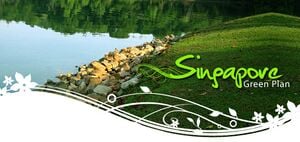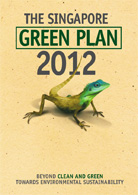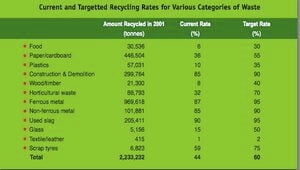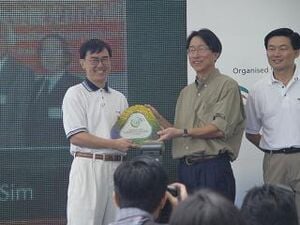
The Singapore Green Plan 2012 is a outline overseen by the Singaporean Ministry of The Environment and Water Resources, for reaching environmental sustainability in Singapore by 2012. Started in 2002 at the World Summit on Sustainable Development in Johannesburg, South Africa, Singapore set a blueprint for reducing waste, increasing public health, conserving resources, addressing climate change and keeping water and land clean.
"We strive to forge a country that will give our people and all who come after them, their best home possible, exercising wise and judicious stewardship of our resources, and optimizing the balance between Man and Nature. With intelligent innovation and strategic partnerships, we will prevail over our limitations, to build a Singapore that will endure for generations to come.[1]

Pamphlet[edit | edit source]
The Singapore Green Plan, available in PDF and print form, is a widely distributed pamphlet that details the ways the Ministry of the Environment and Resources strives towards a more sustainable Singapore. Revisions have taken place in 2005 and 2006.The Pamphlet details ways in which Singapore pledges to become more sustainable.
1. Waste[edit | edit source]
SGP details that because of their limited land availability they are pursuing a "zero landfill" objective in the longer term, with their target being 60 % recycling by 2012. The Waste Minimization and Recycling Association has been started also as a private sector initiative for assistance with industry.

2. Wildlife and Nature[edit | edit source]
Indigenous plants and animals are being documented and monitored. Land is being set aside for nature reserve parks. Protected Nature Reserves are plentiful including, the Bukit Timah Nature Reserve, the Central Catchment Nature Reserve, the Sungei Buloh Wetland Reserve and the Labrador Nature Reserve.
3. Air[edit | edit source]
A National Energy Efficiency Committee was set up in 2001 to work towards energy efficiency in industries, homes, commercial buildings and vehicles.[4]
4. Water[edit | edit source]
Singapore's Public Utilities Board spends close to $542 million dollars a year on water, drainage and sewer projects. Implementation of mandatory water saving devices, water audits, and public water education are among some of the ways Singapore has battled water shortages. Half of Singapore's land surface is water catchment. Also Singaporeans are being encouraged by the government to use less water currently they use 162 liters of water per person per day and the government wants this reduced to 155 liters by 2012.[5]
5. Health[edit | edit source]
The average life span in Singapore is 78 and the infant mortality rate has declined to 2.2 per thousand births. This will be strengthened by quicker responses to diseases and improved disease scanning.

6. Public Education[edit | edit source]
SGP strongly encourages partnerships among the 3P, People, Private and Public. They feel it will create a environmentally aware and responsible nation.[7] Environmental education is stressed within school through programs run by the Ministry of the Environment and the Singapore Environmental Council.
Notes[edit | edit source]
- ↑ http://web.archive.org/web/20120722032228/http://app.mewr.gov.sg/web/Contents/Contents.aspx?ContId=1342
- ↑ http://app.mewr.gov.sg/data/ImgCont/1342/key01.jpg
- ↑ http://web.archive.org/web/20120424125354/http://app.mewr.gov.sg:80/web/Common/homepage.aspx
- ↑ http://www.thomsons.asia/page/12260/asia/reward-news-knowledge/employee-rewards-and-benefits-news/articles
- ↑ http://app.mewr.gov.sg/data/ImgCont/1342/key01.jpg
- ↑ http://www.cleanairnet.org/caiasia/1412/article-73284.html
- ↑ http://web.archive.org/web/20120424125354/http://app.mewr.gov.sg:80/web/Common/homepage.aspx